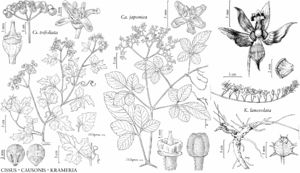Krameria
Iter Hispan., 176, 195, 231. 1758.
| Taxon | Illustrator ⠉ | |
|---|---|---|
 | Cissus trifoliata Causonis japonica Krameria lanceolata | Alice Tangerini Alice Tangerini |
Stems consisting of long-shoots only or long and short-shoots, canescent, strigose, or villous; bark gray or brown. Leaves: blade linear to ovate, ape× mucronate, acute, or obtuse, surfaces canescent, strigose, or villous, sometimes with stalked glandular-hairs. Inflorescences with leafy bracts. Flowers: sepals purple, pink, or magenta [yellow or brown], lanceolate to ovate or oblong; petals smaller than sepals, secretory petals pink, red, redbrown, green, yellow, purple, or orange, orbiculate to cuneate, petaloid petals green or yellow with expanded distal portions partially purple or pink; stamens pink, green, or white, didynamous or equal; ovary strigose or tomentose; style curved, red, pink, or greenish white, glabrous; stigma recessed. Capsules globose or slightly compressed laterally, circular or cordate in outline with longitudinal ridge across 1 or both faces; spines slender to stout, glabrous or hairy proximally, smooth or with retrorse or recurved barbs distally. Seeds brown. x = 6.
Distribution
United States, Mexico, West Indies, Central America, South America
Discussion
Species 18 (4 in the flora).
Selected References
None.
Key
| 1 | Herbs, decumbent; inflorescences terminal, secund racemes; stamens equal. | Krameria lanceolata |
| 1 | Shrubs, erect; inflorescences axillary, solitary flowers; stamens didynamous. | > 2 |
| 2 | Sepals reflexed; secretory petals with oil-filled blisters covering outer surfaces; petaloid petals distinct, narrowly oblanceolate; spines on capsules slender, bearing unicellular hairs basally and amber-colored recurved barbs to 1 mm near tip. | Krameria bicolor |
| 2 | Sepals ± cupped inward or around petals and gynoecium; secretory petals with oil-filled blisters mostly on distal portions of outer surfaces; petaloid petals connate basally, free portions oblanceolate to reniform; spines on capsules stout, usually bearing curved multicellular hairs on basal 1/2 and retrorse barbs near tip, or glabrous, sometimes with minute serrations near tip. | > 3 |
| 3 | Shrubs 1–2 m; leaf blades linear to linear-lanceolate, sometimes with multicellular, stipitate, glandular hairs; styles pink; spines on capsules 2–5 mm. | Krameria erecta |
| 3 | Shrubs 0.3–1 m; leaf blades linear to ovate, lacking glandular hairs; styles greenish white; spines on caspules 0.5–1.5 mm. | Krameria ramosissima |